Sarajevo,
April 30 - May 1, 1998
After a seven year wait, I finally saw Sarajevo in early May. I went
there for a conference at SFOR headquarters in Ilidza, a suburb southwest
of the city. The Zelesnica river runs through the center of Ilidza
with the SFOR headquarters on the south side of the river. Ilidza
was a predominately Serb suburb, so it avoided the artillery attacks and
house to house fighting which occurred to the east at Dobrinja, site of
the 1984 Olympic village. The town is in very good condition.
SFOR headquarters is located in what was once a resort. The Hotel
Srbija, opposite the Hotel Herzegovina on the SFOR compound, is where Arch
Duke Ferdinand and his wife stayed the night before Gravilo Princip assassinated
them in Sarajevo (the summer of 1914). In
the photo below you can see the flags of SFOR participating nations.
We ate lunch in the Srbija dining room and visited the gift shops in the
hotel.
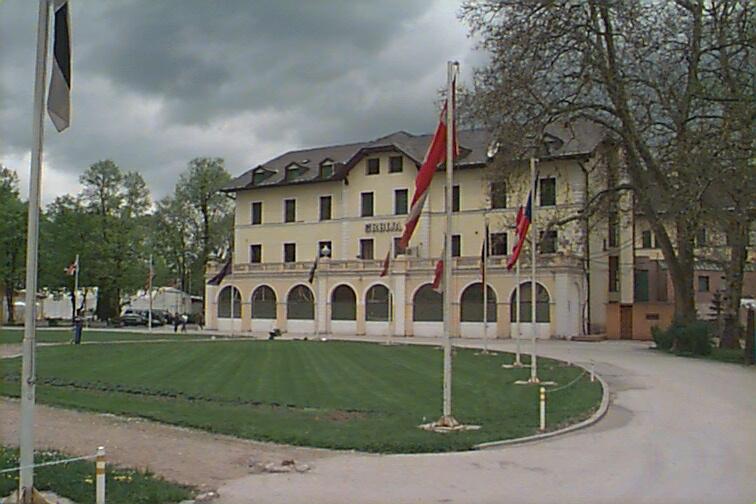 Ilidza was incredibly busy during our visit. In fact we wound up
sitting in two Staus (German word for traffic jam) trying to enter town.
There were hundreds of vehicles backed up for 4-6 kilometers, extending
back into downtown Sarajevo. Coming from Sarajevo, there is
only one route into Ilidza. Everyone jockeys for position where the
road changes from two lanes to one. The rules of the road are very
similar to those I observed in Saudi Arabia. Lane changes without
signaling are the norm and "right of way by tonnage" is the order of the
day. Actually, it is amazing to see so much activity on the road.
People move about as if the war is only a distant memory.
Ilidza was incredibly busy during our visit. In fact we wound up
sitting in two Staus (German word for traffic jam) trying to enter town.
There were hundreds of vehicles backed up for 4-6 kilometers, extending
back into downtown Sarajevo. Coming from Sarajevo, there is
only one route into Ilidza. Everyone jockeys for position where the
road changes from two lanes to one. The rules of the road are very
similar to those I observed in Saudi Arabia. Lane changes without
signaling are the norm and "right of way by tonnage" is the order of the
day. Actually, it is amazing to see so much activity on the road.
People move about as if the war is only a distant memory.
Sarajevo and many of its suburbs remain in sad condition, even today, two
and a half years after the end of the civil war. The apartment complexes
located in the former Olympic village across the street from the Sarajevo
International Airport, are so badly damaged they are uninhabitable.
Despite the fact most of these virtually destroyed apartments are dangerous
or uninhabitable, many people still live in them.
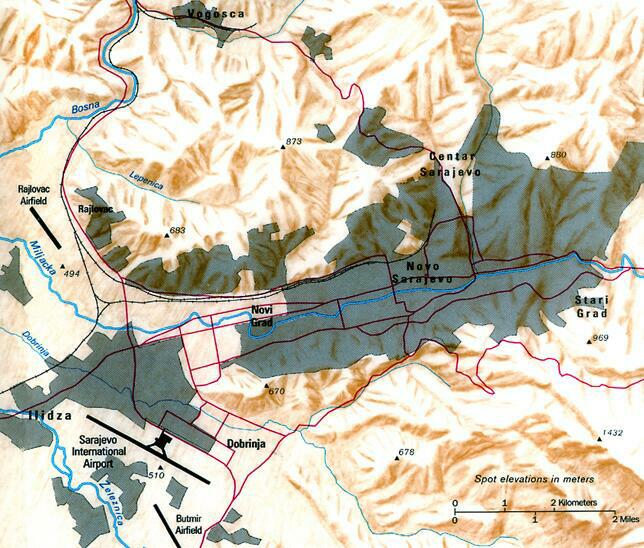 The most heavily damaged section of Sarajevo lies just north of the Sarajevo
International Airport (SIA). These suburbs were heavily damaged during
the war. Many yards and most of the open space still remains heavily
mined today. The extensive damage one sees initially makes you wonder
how there could ever be any hope at all for the future. However,
a closer look yields signs of hope amidst the destroyed homes and broken
lives. Many of these houses have new roofs and there is a flurry
of activity throughout the suburbs as people try to return to this part
of the city and rebuild their homes and lives.
The most heavily damaged section of Sarajevo lies just north of the Sarajevo
International Airport (SIA). These suburbs were heavily damaged during
the war. Many yards and most of the open space still remains heavily
mined today. The extensive damage one sees initially makes you wonder
how there could ever be any hope at all for the future. However,
a closer look yields signs of hope amidst the destroyed homes and broken
lives. Many of these houses have new roofs and there is a flurry
of activity throughout the suburbs as people try to return to this part
of the city and rebuild their homes and lives.
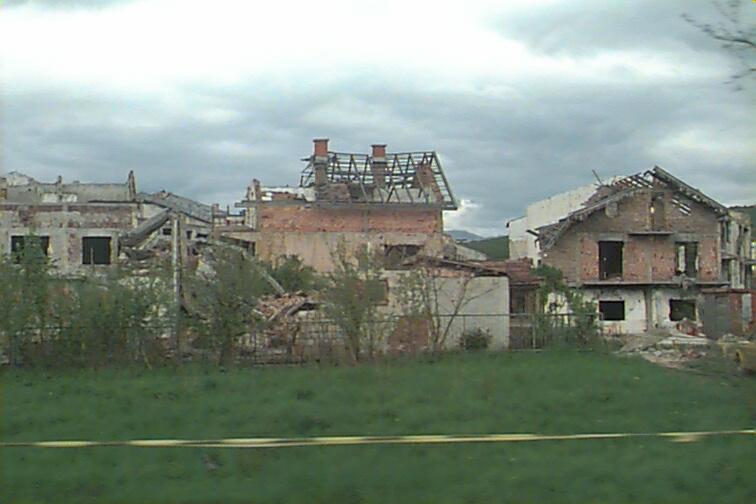
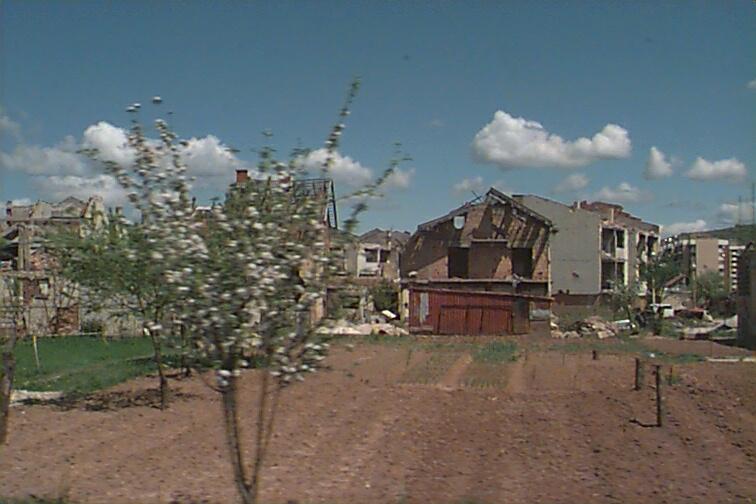
People are trying to move on with their lives. This is indeed an
encouraging sign in a city known to most Westerners only for its tragedy
and bloodshed. The first time most of us ever hear of Sarajevo is
usually in a history class when we learn about the twilight of the Austro-Hungarian
Empire. Many of us recall Gravilo Princip's assassination of
Arch Duke Franz Ferdinand in Sarajevo. Yet, we are hard pressed to
remember Sarajevo was not always a sad and tragic place. Sarajevo
was once (before 1992) a tolerant, multi-ethnic city. Serbs, Bosniacs
(Muslims), and Croats lived together peacefully. The city welcomed
Jews who escaped the Spanish Inquisition and later built a small community
in the city. Sarajevo hosted the 1984 Winter Olympic games, however,
these positive images are but distant recollections in the western mind
today. Snipers and artillery barrages are the enduring images of
Sarajevo most people will remember far into the future.
There are, however, fresh signs of hope. Recently, money from the
international community has been pouring into the city for reconstruction.
Many of the heavily damaged houses in the Butmir suburb have new roofs,
as evidenced by the bright orange tiles you see as you drive by.
Although re-construction is well under way, the ethnic composition of the
city has changed forever. Thousands of the Serb residents fled the
city at the end of the war and most have no plans to return any time soon,
if ever. This has a ripple effect around the country. The Bosniacs
can not return to Srebrenica until the Serbs displaced from Sarajevo (who
now live in Srebrenica) return home. This same story is repeated
hundreds of times across Bosnia. Nearly three years since the war
ended and as long as six years since many people fled or were chased from
their homes, thousands of people are still unable to return to their homes.
 Sarajevo
from the Turkish Fort on the eastern edge of the city
Sarajevo
from the Turkish Fort on the eastern edge of the city
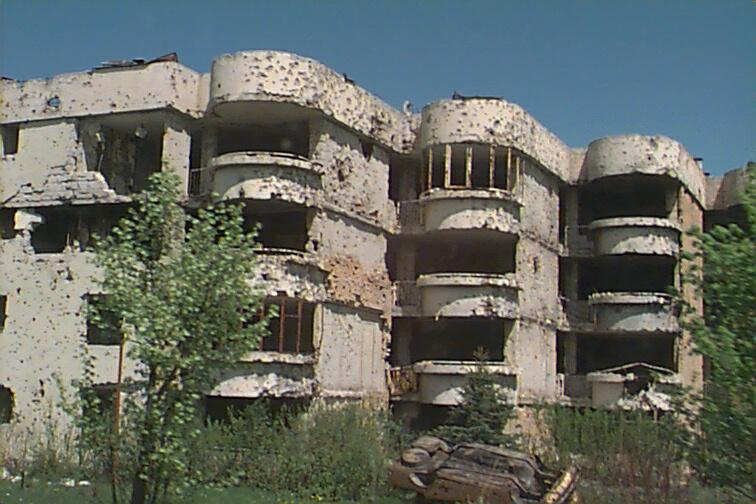 Destroyed
homes in Butmir (May '98)
Destroyed
homes in Butmir (May '98)
Sniper
Alley, three years later (May '98)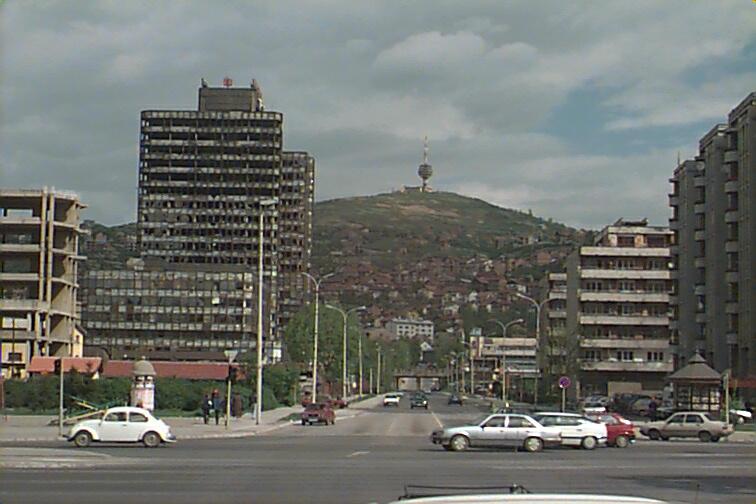
My trip to Sarajevo allowed me to finally see the places I watched time
and time again on television during the war. It's sad to see the
outcome of wanton destruction which results from a few politician's ability
to manipulate others. Perhaps the city will be rebuilt again in the
near future. The spirit that was once prevalent will, however, only
return many years, if ever, in the future.
Chris Wyatt
July 3rd, 1998
 Return
to previous page
Return
to previous page
 Ilidza was incredibly busy during our visit. In fact we wound up
sitting in two Staus (German word for traffic jam) trying to enter town.
There were hundreds of vehicles backed up for 4-6 kilometers, extending
back into downtown Sarajevo. Coming from Sarajevo, there is
only one route into Ilidza. Everyone jockeys for position where the
road changes from two lanes to one. The rules of the road are very
similar to those I observed in Saudi Arabia. Lane changes without
signaling are the norm and "right of way by tonnage" is the order of the
day. Actually, it is amazing to see so much activity on the road.
People move about as if the war is only a distant memory.
Ilidza was incredibly busy during our visit. In fact we wound up
sitting in two Staus (German word for traffic jam) trying to enter town.
There were hundreds of vehicles backed up for 4-6 kilometers, extending
back into downtown Sarajevo. Coming from Sarajevo, there is
only one route into Ilidza. Everyone jockeys for position where the
road changes from two lanes to one. The rules of the road are very
similar to those I observed in Saudi Arabia. Lane changes without
signaling are the norm and "right of way by tonnage" is the order of the
day. Actually, it is amazing to see so much activity on the road.
People move about as if the war is only a distant memory.




 Destroyed
homes in Butmir (May '98)
Destroyed
homes in Butmir (May '98)
